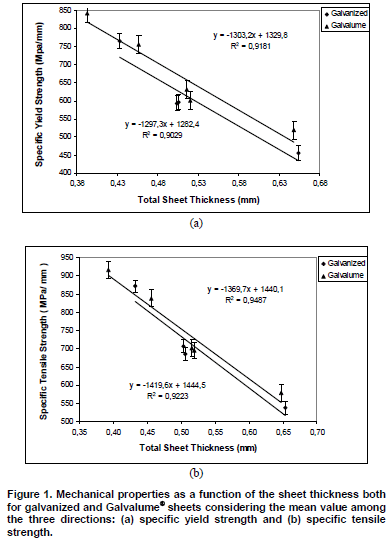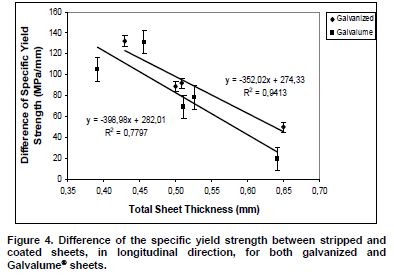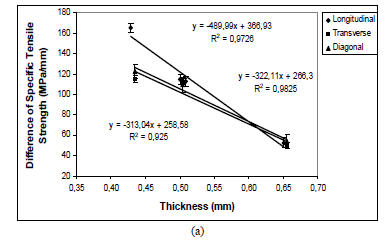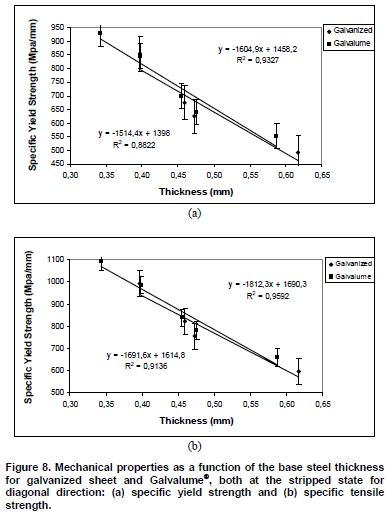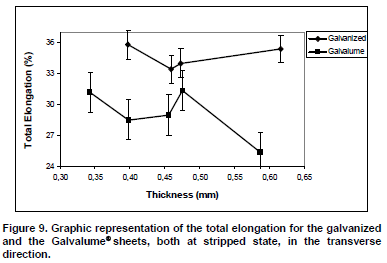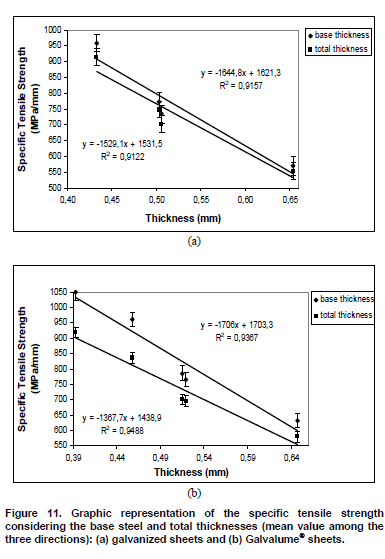Abstract
Steel sheet coated with zinc or 55%Al-Zn is widely used at the civil construction, mainly for roofing and cladding applications. The 55%Al-Zn coated steel shows mechanical properties slightly different from zinc coated steel, even under the same heat cycle processing, due to the higher molten metal temperature and also to the higher strength of the 55%Al-Zn coating. The knowledge of those differences can be used by the final users to evaluate if some of those products are not suitable for any specific application. Although those two coated products are widely used at the civil construction in Brazil, only a limited literature is available on the difference between the mechanical properties of those products. Through tensile tests of commercial grade samples - as coated and after removing the coating - the aim of this paper is to evaluate the mechanical properties (tensile strength, yield strength, total elongation and hardening coefficient) and also how much the coating influences the mechanical properties of the zinc and 55%Al-Zn coated steel. The 55%Al-Zn coated steel showed higher yield and tensile strength and lower total elongation and hardening coefficient compared to zinc coated steel and the coating showed a significant influence on the mechanical properties of both products.
galvanized steel; galvalume®; mechanical properties
Study of the mechanical properties of the hot dip galvanized steel and galvalume®
N. ConiI; M. L. GipielaII; A. S. C. M. D'OliveiraIII; P. V. P. MarcondesIV
III sofmat@ufpr.br
IVmarcondes@ufpr.br, Universidade Federal do Paraná - UFPR Caixa Postal 19011 81531-990, Curitiba, PR, Brazil
ABSTRACT
Steel sheet coated with zinc or 55%Al-Zn is widely used at the civil construction, mainly for roofing and cladding applications. The 55%Al-Zn coated steel shows mechanical properties slightly different from zinc coated steel, even under the same heat cycle processing, due to the higher molten metal temperature and also to the higher strength of the 55%Al-Zn coating. The knowledge of those differences can be used by the final users to evaluate if some of those products are not suitable for any specific application. Although those two coated products are widely used at the civil construction in Brazil, only a limited literature is available on the difference between the mechanical properties of those products. Through tensile tests of commercial grade samples - as coated and after removing the coating - the aim of this paper is to evaluate the mechanical properties (tensile strength, yield strength, total elongation and hardening coefficient) and also how much the coating influences the mechanical properties of the zinc and 55%Al-Zn coated steel. The 55%Al-Zn coated steel showed higher yield and tensile strength and lower total elongation and hardening coefficient compared to zinc coated steel and the coating showed a significant influence on the mechanical properties of both products.
Keywords: galvanized steel, galvalume®, mechanical properties
Introduction
Due to the many favorable characteristics, steel is well suited and widely used for a broad number of engineering applications. It exhibits a variety of excellent mechanical properties, such as strength, toughness and ductility (Akoy et al., 2004). Steel is also easily manufactured and presents good formability, weldability and paintability (Kumar, 2002). Other positive factors include its availability, ferromagnetic properties, recyclability and low cost. Because steel is susceptible to corrosion in the presence of moisture and to oxidation at elevated temperatures, successful use of these favorable characteristics generally requires some form of protection (Dafydd et al., 2005).
Corrosion protection methods employed to protect steel include: altering the metal by alloying, changing the environment by lowering its humidity or by using inhibitors, controlling electrochemical potential by applying cathodic or anodic currents and applying organic and metallic coatings (Parisot et al., 2004). Application of metallic coatings by a continuous hot dip process is one of the most widely used means of protecting steel. In this process, the metallic strip is fed through a bath of molten coating metal in a continuous process.
Metals and alloys that can be applied as coatings to steel in a continuous hot dip process are limited to those with a melting point low enough to allow steel to be pulled through a coating bath without tearing. These include the coatings: zinc, zinc-iron alloy, aluminium, aluminium-silicon alloy, Zn-5Al alloy and 55%Al-Zn alloy. Metals such as chromium and titanium cannot be applied to steel by hot dipping because of their high melting points (Townsend, 1993).
Low-carbon steel sheets coated by hot dipping are available with a broad range of mechanical properties. Compared to uncoated steel, they have slightly less ductility because of the thermal effects of the coating process on the precipitation of carbon in the steel associated with age hardening (Safaeirad et al., 2008). Extra-deep-drawing-quality grades and interstitial-free steel are made with steel that has been vacuum degassed to very low carbon levels and stabilized with additions of titanium and/or niobium (Gupta and Kumar, 2006). The stabilized substrates are relatively immune to the thermal effects of hot dipping and provide excellent formability (Livatyali et al., 2000).
Galvalume® coated steel sheet with 55 % of Al was developed and has been sold by Bethlehem Steel Corporation since 1972 and, due to its favorable properties, several of the bigger steel companies around the world are licensed to use the Galvalume® production technology. In Brazil, Companhia Siderúrgica Nacional - CSN - is nowadays the only company licensed to produce Galvalume® , which has been produced since 2003 at the Continuous Galvanizing Line #5 (CGL#5), located in Araucária city - State of Paraná.
Galvalume® shows different mechanical properties compared to galvanized sheet due to the necessary higher temperature for the 55%Al-Zn alloy molten coating metal (465 ºC for zinc and 600 ºC for 55%Al-Zn alloy). Also the 55%Al-Zn coating shows higher strength compared to zinc coating.
The aim of this paper is to compare and to evaluate the different results of the mechanical properties (tensile strength, yield strength, total elongation and hardening coefficient) of the galvanized sheets and Galvalume® coated sheets and also to evaluate how much the coating influences the mechanical properties of both coated products. This was done through tensile tests conduced with coated and stripped samples cut from steel sheets produced at CGL#5.
Nomenclature
t
= yield strength calculated based on the total or coated thickness, MPa
Greek Symbols
Zinc Coatings
Hot-dip-zinc-coated steel sheet, also called galvanized sheet, is by far the most widely used coated sheet product. For general applications, the galvanized sheets have 19 µm of zinc thickness per side. This corresponds to a two-side coating mass of 275 g/m2. Heavier coatings are used in applications which require higher corrosion resistance, such as highway drainage culverts. In the automobile industry, where formability and weldability are key considerations, lighter coatings such as 90 g/m2 are more typical (Townsend, 1993). The galling, a form of adhesive wear, affects the cost of forming steel in automotive stamping since it increases die maintenance costs and scrap rates (Kim et al., 2008).
Most of the coating is nearly pure zinc. There is an intermetallic layer containing about 6 % Fe, between the substrate and the zinc coating.
Aluminium, typically in the range of 0.1 % to 0.2 %, is added to the zinc bath in order to prevent the formation of a thick, continuous zinc-iron intermetallic layer that could lead to poor coating adhesion during forming. Aluminium reacts preferentially with the steel to form a thin iron-aluminium intermetallic layer which acts as a barrier and delays the growth of the zinc-iron intermetallic layer.
Galvalume® is the trade name of steel sheets coated with 55%Al-Zn alloy. It is applied by a continuous hot dip process similar to that of galvanized coatings. This coating combines the durability of aluminium and the galvanic protection of the zinc, resulting in a product which shows excellent corrosion resistance in marine and industrial environments, high temperature oxidation resistance, heat reflectivity of the aluminium coatings and a pleasant and distinctive appearance.
The chemical composition of the coating is 55 % of Al, 43.5 % of Zn and 1.5 % of Si and it is composed of a three-phase structure as described below (BHP Steel, 1994a):
a) a thin quaternary alloy layer, composed of Al, Zn, Fe and Si, between the steel base and the main coating layer;
b) an aluminium rich dendritic phase (80 % by volume) and
c) a zinc rich interdendritic phase.
All the three phases are necessary to provide the improved corrosion resistance properties. The zinc-rich phase gives the coating its galvanic protection ability, a similar property to a normal galvanized coating. The aluminium rich phase and the alloy layer provide to the coating its durability once the zinc-rich phase is consumed. About 1.5 % silicon is added to the molten bath in order to control the growth of the alloy layer during the dipping process (BHP Steel, 1994a).
As the specific weight of aluminium is lower than that of the zinc, the 55%Al-Zn coating is lighter than the zinc coating, both with same coating thickness. For instance, the weight of the zinc coating designed as G90 (ASTM A653) is 275 g/m2 while the weight of 55%Al-Zn coating designed as AZM150 (ASTM A792) is 150 g/m2. Notice that both coatings have about the same thickness of 20 µm per side which results in higher covering area per ton of Galvalume® compared to a galvanized product. As an example of the difference, one ton of 0.45 mm Galvalume® can cover 4.5 % more area than the same thickness of a galvanized sheet (BHP Steel, 1994b).
The 55%Al-Zn coating shows long-term atmospheric corrosion resistance due to the combination of the durability of aluminium which acts as a mechanical barrier and the galvanic protection given by zinc (Gronostajski, 1995). Exposition tests of the zinc coated steel sheet (coating G90) and Galvalume® (coating AZM 150) were done by Bethlehem Steel. The test panels were exposed at rural, industrial, moderate marine and severe marine environments. The results showed that the corrosion resistance of the 55%Al-Zn is generally at least two to four times higher than that of an equal thickness of galvanized coating (BHP Steel, 1994a). Recent work found that the zinc coating experiences a degree of corrosion between 1.7 times (marine-industrial atmosphere) and 4.5 times (rural atmosphere) greater than that of the 55%Al-Zn coating, considering the results obtained after five years of atmospheric exposure (Palma et al., 1998).
The steel sheet coated with 55%Al-Zn alloy can be used at higher temperature conditions compared to the zinc coated steel sheet. In terms of appearance at higher temperatures, Galvalume® maintains its superficial brightness up to 320 ºC, while the galvanized sheet maintains its brightness up to 230 ºC (BHP Steel, 1994c).
The Estimated Soluble Carbon in Steel Substrate of Galvanized and Galvalume® Sheets
Because of the higher molten metal temperature and the higher cooling rate at the up-leg cooling during a 55%Al-Zn coated steel production (BHP Steel, 1994c), higher levels of carbon in solid solution of the substrate of 55%Al-Zn coated sheets compared to the substrate of galvanized sheets are expected (Lake and Browne, 1978). In pure iron, the solubility of carbon in the body-centered cubic cell was measured as a function of temperature (Lake and Browne, 1978). Table 1 shows some of the values of the carbon solubility.
The values shown in Table 1 are equilibrium values and they are not necessarily achieved in the practical line situation. At 600 ºC the equilibrium solubility are approached within few seconds, but at 450 ºC several minutes may be required to achieve the equilibrium depending on the previous metallurgical history of the steel (Lake and Browne, 1978). Based on the statement as the 55%Al-Zn coated steel is rapidly cooled from 600 ºC, it is expected that soluble carbon levels will be of the order of 60 ppm. The zinc coated steel is held at about 465 ºC before the immersion and than cooled at a lower rate (compared to 55%Al-Zn coated steel). The carbon level will be somewhat greater than 13 ppm, because there will not be enough time for the carbon to precipitate to its equilibrium value at 450 ºC. The measurements of the actual carbon content in a solid solution for 55%Al-Zn and for zinc coated steel exhibit values of 45-60 ppm and 20-30 ppm, respectively, so that there is a significant difference between the levels for the two products (Lake and Browne, 1978; Marder, 2000). Those differences in carbon content in solid solution can represent significant differences for the mechanical properties between 55%Al-Zn and zinc coated steel sheets (Safaeirad et al., 2008). The higher levels of soluble carbon of the 55%Al-Zn coated steel may possibly increase the yield and tensile strength, and decrease the ductility (measured by the total elongation).
Experimental Procedure
The steel used to produce the commercial coated grades according to ASTM A653M (2004) and ASTM A792M (2003) corresponds to a SAE 1006. The hot rolling temperature was 870 ºC, the hot coiling temperature was 610 ºC and the cold rolling reduction ranged from 70 % to 80 %.
The process parameters used to produce the coated (zinc and 55%Al-Zn) steel sheets, from which the samples were obtained, are described in Table 2. The zinc and 55%Al-Zn coated steel products were produced in such a way to meet the requirements described at the ASTM A653M and ASTM A792M standards, respectively.
The annealing temperatures of the steel substrates were the same, regardless of the applied coating. With the exception of the strip temperature at the slow cooling section which was 20 ºC lower for 55%Al-Zn due to operational reasons, and for the strip temperature at the snout which was higher during the 55%Al-Zn coated steel production (560 ºC to 580 ºC) due to the higher molten metal temperature in the pot. The processing speeds were controlled according to the heat capacity of the annealing furnace.
The galvanized and Galvalume® steel sheets, from which the samples were obtained, were collected during the normal production of the Continuous Galvanized Line. Four different thicknesses for galvanized sheets and five for Galvalume® sheets were selected. Six samples were cut from each steel sheet to perform coated and stripped tensile tests for the three directions (longitudinal, transversal and diagonal). Table 3 shows the quantity of prepared samples (from each selected sheet), the tests performed and the cutting direction regarding the rolling direction.
The present study was conducted by using zinc and 55%Al-Zn coated sheets with approximately the same thicknesses. One coating designation for each one of the coatings was chosen as described in Table 4. The coating mass was determined according to ASTM A90 (1993). For the stripped tensile tests, the coating was removed with dilute hydrochloric acid.
The tensile testing was conducted using a Shimadzu Universal Testing Machine with an extensometer. The cross head speed was 3.0 mm/min up to 1.5 % elongation, when the speed was increased to 10.0 mm/min until the end of the test. The gauge length was 80.0 mm. The tensile strength, the yield strength (0.2 % offset) and the total elongation were obtained from stress strain curves. The strain hardening exponent was determined directly from the tensile machine software (EMIC).
Results and Discussions
Comparison between Galvanized and Galvalume® Sheets - as Coated
As expected, the steel sheets coated with 55%Al-Zn alloy showed higher yield and tensile strengths compared to the galvanized sheets for all range of thicknesses (from 0.35 mm to 0.65 mm) and for the three directions. For better analysis of the yield and the tensile strength data, a relation of these properties and the sheet thickness was used according to the Eq. (1) and (2) described below:
where:
YSs = specific yield strength (MPa/mm);
TSs = specific tensile strength (MPa/mm);
YS = yield strength (MPa);
TS = tensile strength (MPa);
t = sheet thickness (mm) or total thickness (mm) which means the sum of the base steel and coating thicknesses.
The values of the specific yield strength and the specific tensile strength, both for galvanized and Galvalume® sheets, showed a good correlation with the sheet thickness as can be observed in Fig. 1. These properties can be represented as a function of the sheet thickness through the 1st grade equations as shown in Fig. 1.
Again, as expected, the galvanized sheet showed higher total elongation than that of the steel sheet coated with 55%Al-Zn alloy for all of the range of thicknesses and for the three directions. The total elongation showed some correlation with the sheet thickness, Fig. 2.
The equations of the straight lines showed in Fig. 2 are rewritten below:
Equation (5) represents the difference between Eqs. (3) and (4) and shows the difference of the total elongation between the galvanized and Galvalume® sheets as a function of the thickness.
Through the above equation, it can be verified that, for 0.50 mm of total thickness, the galvanized sheet should present total elongation of 7.27 % higher than the Galvalume®sheet.
The galvanized sheet showed higher hardening coefficient than that of the steel sheet coated with 55%Al-Zn alloy for all of the range of thicknesses and for the three directions. The hardening coefficient also shows some correlation with the total thickness in the three directions, as can be observed in Fig. 3.
The Influence of the Coating on the Mechanical Properties
In order to study the influence of the coating on the mechanical properties, comparative measurements were made for stripped (after removing the coating) and coated sheets for both galvanized and Galvalume® sheets.
The specific yield strength (Fig. 4) and the specific tensile strength (Fig. 5) of the stripped samples were higher than that of the coated samples, which means that the presence of coating decreases the specific yield and tensile strengths of the galvanized and Galvalume® sheets. The straight lines shown in Fig. 4 represent how much the specific yield strength of the stripped sheets is higher than that of the coated sheets. The zinc coating showed the higher influence on the reduction of the specific yield strength between the stripped and the coated sheets. Figure 4 also indicates that the yield strength of 55%Al-Zn is higher than that of the zinc coating.
It can be observed in Fig. 5 that the difference of the specific tensile strength between stripped and coated sheet decreases with the increasing of the sheet thickness due to the decreasing of the ratio between coating thickness and the base steel thickness.
The stripped sheets showed higher total elongation than the coated sheets for both galvanized and Galvalume® sheets, Fig. 6. The presence of the coating has a detrimental effect on the total elongation. It can be observed that the detrimental effect is higher for 55%Al-Zn coating than that of the zinc coating.
For the galvanized sheets, a considerable difference of the hardening coefficient between the stripped and coated states was not observed. However, for the Galvalume® sheets, a significant difference of this property was observed in the three directions, as can be seen in Fig. 7, which indicates that the 55%Al-Zn coating has a detrimental effect on the hardening coefficient.
Considering the equations shown in Figs. 7a e 7b, a difference in the hardening coefficient between the coated and stripped states was observed, which are 0.0342 for 0.50 mm thickness in the transverse direction and 0.0398 in the diagonal direction.
It can also be observed that the hardening coefficient of the coated sheet increases as the total thickness increases due to the decreasing of the ratio between coating thickness and the base steel thickness.
Comparison between Galvanized and Galvalume® Sheets - Stripped State
By comparison of the galvanized and Galvalume® sheets, both at the stripped state, it can be verified that the Galvalume® sheet showed yield and tensile strengths slightly higher than that of the galvanized sheet. This observation is an indicative of the action of the higher molten metal temperature of the 55%Al-Zn bath compared to the zinc bath, and the higher cooling rate of the coating during Galvalume® processing on the base steel properties. Figure 8 shows the specific yield and tensile strengths for galvanized and Galvalume® sheets, both at the stripped state and in the diagonal direction.
The influence of the thermal cycle of the galvanized and Galvalume® sheets on the total elongation of the base steel is shown in Fig. 9. The higher molten metal temperature of the 55%Al-Zn bath and the higher cooling rate of the coating required during Galvalume® production lead to a lower total elongation of the stripped samples for Galvalume® sheet compared to the galvanized sheet. A correlation between the total elongation and the strip thickness was not found.
Significant differences of the hardening coefficient of the galvanized and the Galvalume® sheets, both at the stripped state, were not observed.
The Extra Load Resistance of the Coatings
The effect of the 55%Al-Zn and zinc coatings on the yield and tensile strengths depends on the method used to calculate these properties. Up to this point, the total thickness was used to calculate the yield and the tensile strengths (except for the stripped samples). But the standard specifications (ASTM A924 e EN10142) require the calculation of the yield and the tensile strengths using only the base steel thickness (discounting the coating thickness). However, as the zinc and 55%Al-Zn coatings, as well as the base steel, resist the applied tension load, a slight increase in the yield and the tensile strengths of these coatings is expected. That is, the coating will act as an extra load resistance during the tensile test.
The increasing in the yield strength can be calculated as described below:
where:
YSb = yield strength calculated based on the base steel thickness (MPa);
YSt = yield strength calculated based on the total or coated thickness (MPa);
t = total or coated thickness (mm);
tb= base steel thickness (mm).
By substitution of Eq. (7) in Eq. (6):
where:
ΔYS = increasing in the yield strength (MPa);
tc = coating thickness (mm).
A similar equation can be used to evaluate the increase of the tensile strength, when it is calculated using the base steel thickness:
where:
ΔTS = increasing of the tensile strength (MPa);
TSt = tensile strength calculated based on the total or the coated thickness (MPa).
Analyzing Eq. (8) and (9), it can be verified that the increase in the yield and in the tensile strengths is directly proportional to the coating thickness and indirectly proportional to the decrease of the base steel thickness. It was already expected that the thicker the coating and the thinner the steel, the more the extra load-resistance of the coating was. For galvanized sheets and for Galvalume® sheets, the increase in the specific yield strength and the specific tensile strength can be observed in Fig. 10 and 11, respectively.
The extra load-resistance of the 55%Al-Zn coating was higher than that of the zinc coating which is an indication that the 55%Al-Zn coating exhibits higher yield and tensile strengths than the zinc coating.
Conclusion
The steel sheets coated with 55%Al-Zn alloy showed higher specific yield and tensile strengths and lower total elongation and hardening coefficient compared to the galvanized sheets for all ranges of thicknesses (between 0.35 mm and 0.65 mm) and for the three studied directions. Due to the good correlation found between the specific yield strength, the specific tensile strength, the total elongation and the hardening coefficient with the total thicknesses, these properties may be represented as a function of the total thickness through 1st grade equations.
The effect of the 55%Al-Zn and zinc coatings on the yield and tensile strengths depends on the method used to calculate these properties. As the standard specifications (ASTM A924 and EN10142) require the calculation of the yield and tensile strengths using only the base steel thickness (discounting the coating thickness), an extra load resistance during tensile test is expected, because the zinc and 55%Al-Zn coatings, as well as the base steel, resist the applied tension load. The thicker the coating and the thinner the steel, the higher the extra load-resistance of the coating is expected to be.
By comparison between galvanized sheets and Galvalume® sheets, both at a stripped state, it was verified that Galvalume® sheets tend to show higher specific yield and tensile strengths and lower total elongation than that of the galvanized sheets. It was not observed significant difference of the hardening coefficient. These results showed the influence of the different molten metal temperatures and different cooling rates of the coatings on the mechanical properties of the base steel.
The steel sheets coated either with zinc or 55%Al-Zn alloy showed lower specific yield and tensile strengths compared to the stripped sheets. The differences between stripped and coated states increase as the steel base thickness increases and are an indicative that both coatings are less resistant than that of the steel base.
A considerable difference of the hardening coefficient of the Galvalume® sheets was observed between the stripped and coated states in the three directions which means that the 55%Al-Zn coating has a considerable detrimental effect on the hardening coefficient.
Paper accepted May, 2009.
Technical Editor: Anselmo E. Diniz
- Akoy, M.A., Kayali, E.S., Cimenoglu, H., 2004, "The influence of microstructure features and mechanical properties on the cold formability of ferritic steel sheets". ISIJ Int, Vol. 44, pp. 422-428.
- ASTM A653M, 2004, "Standard specification for steel sheet, Zinc-coated (galvanized) or Zinc-Iron alloy-coated (galvannealed) by the hot-dip process", Annual Book of ASTM Standards
- ASTM A 792M, 2003, "Standard specification for steel sheet, 55% Aluminium-Zinc alloy-coated by the hot dip process", Annual Book of ASTM Standards
- ASTM. A 90, 1993, "Standard test method for weight of coating on Zinc-coated (galvanized) Iron or steel articles", Annual Book of ASTM Standards, Vol. 01.06.
- BHP Steel, 1994a, "55% Aluminium-Zinc coated sheet steel research and technology manual", BIEC International Inc, Australia.
- BHP Steel, 1994b, "55% Aluminium-Zinc coated sheet steel marketing manual", BIEC International Inc, Australia.
- BHP Steel, 1994c, "55% Aluminium-Zinc coated sheet steel operating technology manual", BIEC International Inc, Australia.
- Dafydd, H., Worsley, D.A. and McMurray, H.N., 2005, "The kinetics and mechanism of cathodic oxygen reduction on Zinc and Zinc-Aluminium alloy galvanized coatings", Corrosion Science, Vol. 47, pp. 3006-3018.
- Gronostajski, J.Z., 1995, "Behaviour of coated steel sheets in-forming processes". J. Mater. Process. Technol., Vol. 53, pp. 167-176.
- Gupta, A.K., Kumar, D.R.. 2006, "Formability of galvanized interstitial-free steel sheets". Journal of Materials Processing Technology, Vol. 172, pp. 225-237.
- Kumar, D. R., 2002, "Formability analysis of extra deep drawing steel". Journal of Materials Processing Technology, Vol. 130-131, pp.31-41.
- Kim, H., Sung, J., Goodwin, F.E. and Altan,T., 2008, "Investigation of galling in forming galvanized advanced high strength steels (AHSSs) using the twist compression test (TCT)", Journal of Materials Processing Technology, Vol. 205, pp. 459-468.
- Lake, J.S.H. and Browne, K.M., May 1978, "The effect of soluble carbon on mechanical properties of low carbon steel with reference to Zincalume", John Lysaght Limited Research and Technology Centre (Australia).
- Livatyali, H., Duggal, N., Ahmetoglu, M.A. and Altan, T., 2000, "Investigation of crack formation on the galvalume coating of roll formed roof panels", Journal of Materials Processing Technology, Vol. 98, pp. 53-61.
- Marder, A. R., 2000, "The metallurgy of zinc-coated steel". Progress in Materials Science, Vol. 45, pp. 191-271.
- Palma, E., Puente, J.M. and Morcillo, M., 1998, "The atmospheric corrosion mechanism of 55%Al-Zn coating on steel", Yentro National de Investigaciones Metalurgicas, Madrid, Spain. Corrosion Science, Vol. 40, No. 1, pp. 61-68.
- Parisot, R., Forest, S., Pineau, A., 2004a, "Deformation and damage mechanisms of zinc coatings on hot-dip galvanized steel sheets - part 1", Deformation modes. Metall. Mater. Trans, Vol. 35A, pp. 797-811.
- Safaeirad, M., Toroghinejad, M.R. and Ashrafizade, F., 2008, "Effect of microstructure and texture on formability and mechanical properties of hot-dip galvanized steel sheets", Journal of Materials Processing Technology, Vol. 196, pp. 205-212.
- Townsend, H.E., 1993, "Continuous hot dip coatings, ASM Handbook Surface Engineering", Vol. 5, pp. 339-348.
Publication Dates
-
Publication in this collection
19 Feb 2010 -
Date of issue
Dec 2009
History
-
Received
May 2009 -
Accepted
May 2009












